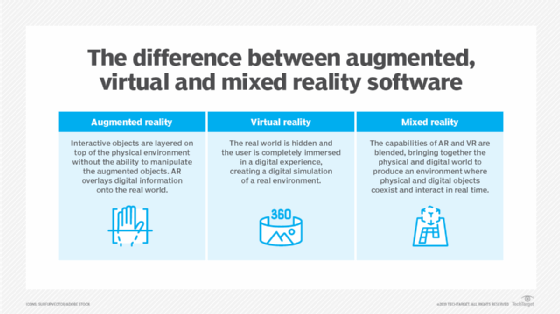
vit_mar - stock.adobe.com
AI and augmented reality blur lines between virtual and reality
Using AI with augmented reality and virtual reality in industries as varied as gaming and conversational systems can enhance the already impressive technologies.
Augmented reality and virtual reality are compelling technologies that can enhance our interaction with the real world. On their own, augmented reality and virtual reality are used to overlay digital information on top of the physical environment we see around us.
The combination of augmented reality (AR) with virtual reality (VR) -- which is more immersive from a user perspective -- has given rise to the concept of mixed reality. Mixed reality merges generated images with existing real-world objects to augment or enhance a user's experience. When combined with AI, however, this technology can become even more transformative.
AI and mixed reality technologies are increasingly working together to provide interactive experiences that blur the lines between what is real and what is computer generated.
Using AI within mixed reality
One of the more common implementations of AI and augmented reality is managing and recognizing real-world items in the context of an AR offering.
An example of this is the face filters used on apps like Snapchat or Samsung messaging. AI is used to determine the face and how it is orientated. The technology is also used to continuously track a person's face and facial expressions.
Without the help of AI, AR would be unable to detect the proper orientation of a person's face. Instead, the movement of your device would determine both the vertical and horizontal axis of your filter.

Another similar implementation of AR is happening within retail stores. A collection of retail stores is now using apps that enable customers to virtually try on clothes. This can be especially helpful for customers that live far from major retail locations. Working with AI, some of these apps can even recommend specific styles and suggest sizes that may look and fit better.
In addition, a few furniture companies, such as Ikea, have harnessed the power of AR to create apps that enable users to virtually place and preview how furniture will appear in a digital version of their house. This helps to eliminate any worries associated with selecting unwanted pieces.
Car companies are also starting to use AI and augmented reality to help make driving safer. Dashboards now feature tools that allow drivers to identify objects in front of them. This technology can identify traffic and road signs and gauge how close cars are in front, behind and next to your own vehicle.
While some of these implementations are still being developed and tested, they hold the potential to make a difference when it comes to road safety. For example, AR and AI can work in tandem with drivers but they can also inform self-driving cars of obstacles and traffic laws.
AR and VR in the world of gaming
Gaming is one of the more common applications of AR and VR, with more than 500 games just for virtual reality. The multiplayer game Pokémon GO was one of the first games to combine AI and augmented reality.
In Pokémon GO, users virtually capture fictional animals while walking around the real world. An accelerometer and gyroscope create an overlay on what users are seeing.
However, the Pokémon do not always appear in proportion or even along a proper axis. The addition of AI to Pokémon GO holds the potential to improve some of these limitations. The result would be a much more immersive gaming world.
Bringing conversation and translation into AR
Another application of AI and augmented reality is the use of natural language processing and translation capabilities. Quest Visual released a ground-breaking application called Word Lens in 2010 that enabled users to point their cameras at signs in different languages and virtually translate them not only into the desired language, but with the right font and graphics.
The system combined aspects of AR with AI, including machine translation and a generative adversarial network, to produce images that fit with the translation. Quest Visual was acquired by Google in 2014 and the technology is now part of the Google Translate application.
There are other AR and mixed reality applications benefiting from the diverse set of capabilities provided by AI. Fully immersive VR headsets use AI capabilities to provide conversational interfaces from voice assistants and to enable chat-based conversations while speaking to the device. This frees users from having to type on a keyboard while they have a VR device strapped to their head. In fact, conversational systems are most likely the only way to enable this sort of interaction in fully immersive devices.
Other AR systems are tackling the areas of digital health and virtual surgery. AI is augmenting these systems by providing support for pattern identification, image and object recognition and aspects of autonomous control, thus freeing up a surgeon or healthcare practitioner to focus on other aspects of providing treatment. In these situations, AI and mixed reality are providing not only added value but potentially helping to save lives by lowering the possibility of error due to fatigue.
In the future, AR and AI might continue to merge in almost science-fiction like ways. "Star Trek" fans might think of the holodeck as a combination of AI systems and mixed reality that can make computer-generated images look and feel like reality.
We may not be too far away from that vision of the intelligent mixed reality interface and, indeed, many of the applications above seem to indicate we may be closer than we think.








